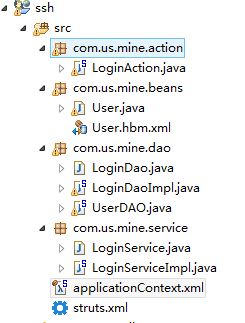参照了这篇博客,但是里面有些地方进行了更改
在昨天添加struts2和hibernate的中间添加spring,比较简单,方法类似,直接finish就可以。hibernate需要next进行相应的选择。
然后自动生成了applicationContext.xml。
注意三个框架的顺序是struts2,spring,hibernate。然后我们可以看到数据库的配置信息加入到了applicationContext.xml。
后面反向生成实体类和dao的时候配置信息也加入到了applicationContext.xml。
但是我们自己编写的dao,impl,service需要自己进行配置

User.java和User.hbm.xml反向生成

package com.us.mine.beans; /** * User entity. @author MyEclipse Persistence Tools */ public class User implements java.io.Serializable { // Fields private Integer userId; private String userName; private String password; private Integer gender; // Constructors /** default constructor */ public User() { } /** full constructor */ public User(String userName, String password, Integer gender) { this.userName = userName; this.password = password; this.gender = gender; } // Property accessors public Integer getUserId() { return this.userId; } public void setUserId(Integer userId) { this.userId = userId; } public String getUserName() { return this.userName; } public void setUserName(String userName) { this.userName = userName; } public String getPassword() { return this.password; } public void setPassword(String password) { this.password = password; } public Integer getGender() { return this.gender; } public void setGender(Integer gender) { this.gender = gender; } }

<?xml version="1.0" encoding="utf-8"?> <!DOCTYPE hibernate-mapping PUBLIC "-//Hibernate/Hibernate Mapping DTD 3.0//EN" "http://hibernate.sourceforge.net/hibernate-mapping-3.0.dtd"> <!-- Mapping file autogenerated by MyEclipse Persistence Tools --> <hibernate-mapping> <class name="com.us.mine.beans.User" table="user" catalog="world"> <id name="userId" type="java.lang.Integer"> <column name="userId" /> <generator class="native" /> </id> <property name="userName" type="java.lang.String"> <column name="userName" length="16" not-null="true" /> </property> <property name="password" type="java.lang.String"> <column name="password" length="16" not-null="true" /> </property> <property name="gender" type="java.lang.Integer"> <column name="gender" not-null="true" /> </property> </class> </hibernate-mapping>
然后是登录页,注意元素的name要和action类中的一致,form的action要和struts.xml中一致。加一个登录成功页main.jsp。

<body> <form method="post" action="Login"> 用户名:<input name="username" type="text" /> 密码:<input name="password" type="password" /> <input name="Submits" type="submit" value="登录" /> <input name="ReSet" type="reset" value="重置" /> </form> </body>
然后LoginDao,LoginDaoImpl,LoginService,LoginServiceImpl

package com.us.mine.dao; public interface LoginDao { boolean login(String username, String password); }

package com.us.mine.dao; import java.util.List; import org.springframework.orm.hibernate3.support.HibernateDaoSupport; import com.us.mine.beans.User; public class LoginDaoImpl extends HibernateDaoSupport implements LoginDao { @Override public boolean login(String username, String password) { List<User> u=this.getHibernateTemplate().find("from User where userName=? and password=?",username,password); Boolean flag=false; if(u.size()>0){ flag=true; } return flag; } }

package com.us.mine.service; public interface LoginService { boolean login(String username, String password); }

package com.us.mine.service; import com.us.mine.dao.LoginDao; import com.us.mine.dao.LoginDaoImpl; public class LoginServiceImpl implements LoginService { private LoginDao logindao; public void setLogindao(LoginDaoImpl loginDao) { this.logindao = loginDao; } @Override public boolean login(String username, String password) { return logindao.login(username, password); } }
然后是LoginAction 并在struts.xml中进行配置,注意action的class填写的和application里面注入的action的id相同

package com.us.mine.action; import com.opensymphony.xwork2.ActionSupport; import com.us.mine.service.LoginService; public class LoginAction extends ActionSupport{ private LoginService loginservice; private String password; private String username; public LoginService getLoginservice() { return loginservice; } public void setLoginservice(LoginService loginservice) { this.loginservice = loginservice; } public String getPassword() { return password; } public void setPassword(String password) { this.password = password; } public String getUsername() { return username; } public void setUsername(String username) { this.username = username; } public String login(){ Boolean flag=loginservice.login(username, password); if(flag){ return SUCCESS; }else{ return INPUT; } } }

<?xml version="1.0" encoding="UTF-8" ?> <!DOCTYPE struts PUBLIC "-//Apache Software Foundation//DTD Struts Configuration 2.1//EN" "http://struts.apache.org/dtds/struts-2.1.dtd"> <struts> <package name="default" extends="struts-default" namespace="/"> <action name="Login" class="logina" method="login"> <result name="input">/index.jsp</result> <result name="success">/main.jsp</result> </action> </package> </struts>
最后是applicationContext.xml。主要是最下面3个bean,可以看到类之间的注入关系

<?xml version="1.0" encoding="UTF-8"?> <beans xmlns="http://www.springframework.org/schema/beans" xmlns:xsi="http://www.w3.org/2001/XMLSchema-instance" xmlns:p="http://www.springframework.org/schema/p" xsi:schemaLocation="http://www.springframework.org/schema/beans http://www.springframework.org/schema/beans/spring-beans-3.1.xsd"> <bean id="dataSource" class="org.apache.commons.dbcp.BasicDataSource"> <property name="url" value="jdbc:mysql://localhost:3306/world"></property> <!-- 加入后解决数据库连接不上错误 --> <property name="driverClassName" value="com.mysql.jdbc.Driver"></property> <property name="username" value="root"></property> <property name="password" value="1234"></property> </bean> <bean id="sessionFactory" class="org.springframework.orm.hibernate3.LocalSessionFactoryBean"> <property name="dataSource"> <ref bean="dataSource" /> </property> <property name="hibernateProperties"> <props> <prop key="hibernate.dialect"> org.hibernate.dialect.MySQLDialect </prop> </props> </property> <property name="mappingResources"> <list> <value>com/us/mine/beans/User.hbm.xml</value> </list> </property> </bean> <bean id="UserDAO" class="com.us.mine.dao.UserDAO"> <property name="sessionFactory"> <ref bean="sessionFactory" /> </property> </bean> <!-- Dao注入sessionFactory --> <bean id="logind" class="com.us.mine.dao.LoginDaoImpl"> <!-- 注入持久化操作所需的SessionFactory --> <property name="sessionFactory"> <ref bean="sessionFactory" /> </property> </bean> <!-- service注入dao id为下面的ref class为service实现类 --> <bean id="logins" class="com.us.mine.service.LoginServiceImpl"> <property name="logindao" ref="logind"></property> </bean> <!-- Action注入service id="" 注入 class="action路径" name="loginservice"与LoginAction中声明的要保持一致 ref随便取 --> <bean id="logina" class="com.us.mine.action.LoginAction" scope="prototype"> <property name="loginservice" ref="logins"></property> </bean> </beans>
运行后一直报错,发现上面的配置文件少了
<property name="driverClassName" value="com.mysql.jdbc.Driver"></property>加上后可以运行
输入
结果

